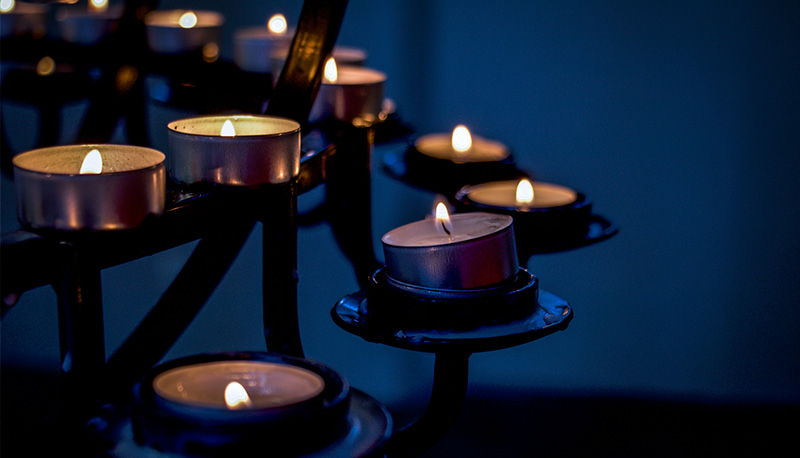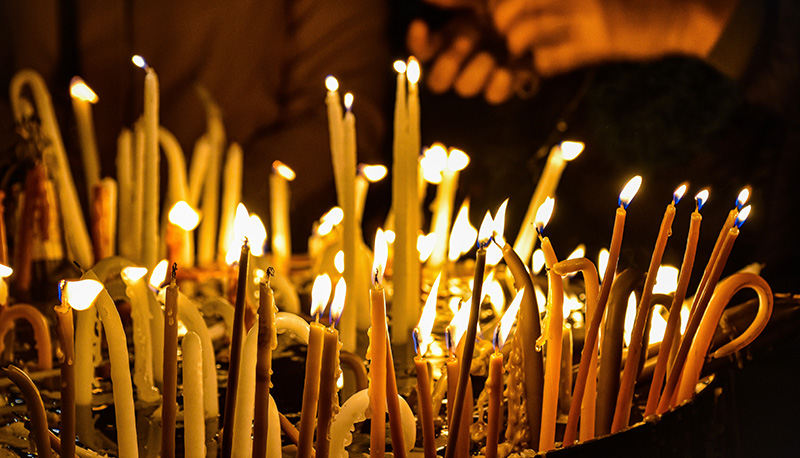
The tradition of lighting candles for the deceased in the house is a possible way to keep their memory alive. The light also represents the union of the living and the deceased. Faith is the best refuge for those who have to go through the process of overcoming the mourning of a loss of any kind and particularity. And the lighted candle symbolizes Jesus as the Light of the World.. Light that we also want to participate in and offer to God.
Jesus said to his disciples: "I am the true light" and "You are the light of the world... Let your light so shine before men, that they may see your good deeds and glorify your Father who is in heaven", Mt 5:16.
In the origins of Christianity, candles or oil lamps were lit on the tombs of deceased saints, particularly martyrs, using the symbolism of light as a representation of Jesus Christ. "In him was life; and the life was the light of men", John 1:4.
That is why today we are accustomed to light candles for the deceased, placing in the hands of God the prayer that we offer in faith. It also symbolizes the desire to stay there, with them, with God, praying and interceding for our needs and those of the whole world, giving thanks, praising and adoring Jesus. For where there is God there can be no darkness.
There is an intimate dimension, related to lighting candles for our deceased, something that concerns each one of us and our silent dialogue with God. This lit candle becomes the symbol of the divine fire that burns in each one of us.The light of which Jesus is a symbol, but of which all of us, as Christians, are a part, makes us an integral part of that light.
"In the light of faith, we beseech the Blessed Virgin Mary to pray with us. And may she intercede with God for our prayers."

Liturgical candles are linked to the firm belief in Jesus Christ as the "light that enlightens the world". "Again Jesus spake unto them, saying, I am the light of the world: he that followeth me shall not walk in darkness, but shall have the light of life." John 8:12.
Lighting candles means, in this case, knowledge of God who is a guide in the darkness. and who, through his Son who descends upon us, opens our eyes and makes us worthy of his presence, of his consideration.
That is why, in the Catholic Church, in addition to candles for the deceased, candles are placed on the altar and near the tabernacle. They accompany the celebrations and are used in almost all the sacraments, from Baptism to Extreme Unction, except for the sacrament of Reconciliation as irreplaceable symbolic elements.
The paschal candle
It is lit during the Easter Vigil, the Holy Mass celebrated on Holy Saturday, after sunset and before sunrise on Easter Sunday, to celebrate the resurrection of Jesus. It is then left on the altar for the entire Easter season and extinguished at Pentecost.
It is lit as a sign of the risen light of Christ, who returns from the dead to illuminate the path of his children and to offer himself for their salvation.
Baptismal candle
During the Baptism, the priest presents a candle, which was lit with the paschal candle.
The white candle in the sacrament of Baptism is a symbol that represents guidance on the path of encounter with Christ. which in turn is the light of our lives and the light of the world. It also symbolizes the resurrection of Christ.
Votive candles
It comes from Latin votumwhich means promise, commitment or simply prayer.
These candles are similar to the candles for the deceased. They are lit by the faithful in front of an altar, a crucifix, an image of the Virgin Mary or of a saint. They have a precise meaning: they express the desire to entrust our words and our thoughts. These lighted candles are common in most churches. They serve an offering, a particular intention and are accompanied by a time of personal prayer.
Tabernacle Candle
The light that illuminates the Tabernacle, indicating the presence of the Body of Christ, is easily recognizable to any Christian who enters a Church.
Nowadays, in many places it is a lamp, not a candle, but still it is one of the most important and precious: the burning flame that symbolizes Jesus and the faith of those who love him. An inexhaustible light that remains lit even when we leave the church.
Advent candles
The Advent wreath, a European custom, began in the mid-19th century to mark the weeks leading up to Christmas.
It consists of a wreath of evergreen branches intertwined together, holding four candles. Each Sunday of Advent a candle is lit and a prayer is said accompanied by a reading from the Bible and a carol may be sung.
Altar candles
They have been used during Holy Mass since at least the 12th century. These candles remind us of the persecuted Christians in the early centuries who secretly celebrated Mass at night or in the catacombs by candlelight.
They can also be used in the entrance and closing processions of the Mass. They are taken to where the Gospel is read as a sign of triumphant joy in the presence of Christ's words.
During the Easter Vigil, when the deacon or priest enters the darkened church with the paschal candle, he recites or sings Light of Christ, to which the faithful respond: Let us give thanks to God. This song reminds us how Jesus came into our world of sin and death to bring us the light of God.
Lighting candles for the deceased
This ancient custom of lighting candles for the deceased was already practiced by the Romans, even earlier by the Etruscans and, even further back, by the Egyptians and the Greeks, who used candles for the deceased in funeral rites, In the Christian religion, visiting the grave of a loved one, bringing flowers, lighting candles for the deceased and stopping to pray, is something comforting and consoling.
Because candles for the deceased are pulsating sentinels, small fragments of light that draw the path to peace for our departed loved ones, it is therefore a good custom to light candles for the deceased and leave them on the tombstones to illuminate the night of the cemeteries. In the light of the candles for the deceased that is consumed, feeding on its own wax, we recognize the human life that is slowly extinguished.
The offering we leave by lighting candles for the deceased is a sacrifice that accompanies our prayer with deeds and makes our intention of faith tangible. Protection, therefore, and guidance, these are the main functions of lighting candles for the deceased mourning. That every year it is customary to re-light, on November 1, All Saints Day, and on the 2nd, All Souls Day or Day of the Dead.
In addition to candles for the deceased, candles play an important role in the blessing of ashes and palms on Palm Sunday. Also in the sacraments, the consecration of churches and cemeteries and the mass of a newly ordained priest. By color and by day, candles can help us to enhance and stimulate moments of prayer.
These candles that we light can be blessed by a priest to help us pray for the sick and place ourselves in God's hands.
In the 2nd century, it was the Romans who decided that the official color of mourning was white, so the candles for the deceased were white. A color recognized by European queens until the 16th century. A white mourning reminds us of the pallor of death and how fragile we are before it, reaffirming the purity of our soul.
For symbolize the time of special waiting and preparation, for example, we can light the white candles of the Advent wreath during Christmas dinner.. In the meantime, we can pray as a family asking for the Child Jesus to be born in the heart of each of its members.
It is also white, the paschal candle. Perhaps the most recognizable for its size and appearance, as it can measure more than a meter high and has colorful designs.
In Ancient Egypt, the color red was considered a symbol of anger and fire. It was also associated with the desert, a place associated with death. In Ancient Rome, it was associated with the color of spilled blood and was linked to both mourning and death.
For example, lighting the red, pink or burgundy candles on the advent wreath represents our love for God and God's love that surrounds us. They correspond to the third Sunday of Advent, and their meaning is one of joy and gladness, because the birth of Jesus is near.
The Catholic Monarchs dictated, in 1502, that black should be the official color of mourning. All this is reflected in the "Pragmatic of Mourning and Wax", a written protocol on how mourning should be carried at that time.